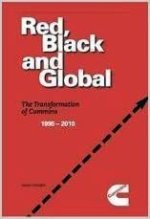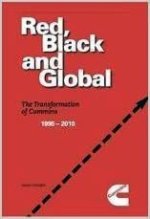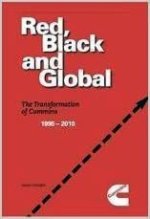TDRComm
Staff Member
Book Review – Red, Black and Global
As recently as Issues 102-107 (November 2018-February 2020) we did a review of Cummins history and focused on the 100 year celebration at Cummins (1919-2019).
Part of that historical review included excerpts from the book Red, Black and Global that was published in 2011. Our Issue 78 magazine had a book review of R,B&G. Our Issue 78 magazine also had further analysis of R,B&G with a detailed seven-page article titled “What Can We Learn” that pulled excerpts from R,B&G that were specific to the Ram/Cummins relationship and expanded the story.
This Issue 78 article has been captured and reprinted in the book A Dodge/Cummins Turbo Diesel Historical Perspective and is available for TDR members to download at no charge at our website.
Now, no foolin’, I know how often (or not) TDR members download the data that is available to you at our member-only area. No foolin’, I must not be a good spokesperson or salesman for our own treasure trove of data. So, here is a quiz, the detailed answers to which you can find by rereading the Issue 78 article in the Historical Perspective book. (Seriously, the answers are at the end of the quiz.)
TAKE THE QUIZ:
1) Exhaust gas recirculation was not needed to meet a 2004 emissions deadline. What was the technology used by Cummins to meet the emission standard?
2) Explain the technology used by Ram/Cummins to meet the 2004 deadline.
3) The use of this technology was implemented in what model year?
4) This technology resulted in a cost savings to Ram and Cummins of
a. 10 million/year b. 100 million/year c. 150 million/year d. 500 million/year
5) Cummins and Ram were facing another set of tighter emissions standards for year 2010. They surprised everyone and met the requirement starting in what year?
6) Three key items gave Cummins the “tools” to meet the 2010 standard. Name the tools.
7) In 1995, Cummins had a V-8 project in the works. The engine finally found a home at Nissan in their Titan pickup truck (2015-2019). Name the other manufacturers (in order) that were offered this V-8 engine.
---Scroll Down for the Answers---



ANSWERS
1) Deep spray.
2) Deep spray: The concept is really pretty simple. As the book states: “The design team played around with lots of concepts. What we were faced with in the ’04.5 emissions compliance was a reduction of NOx from 4.0 to 2.4 /bhp/hr. So, recall from the basics of ‘how to control NOx’ you’ll want to retard the timing. The injection strategy was changed, timing was retarded, and the piston bowl was deeper—hence the name deep spray. An added benefit to the deep piston bowl was that the injected fuel was captured/contained and very little would reach the cylinder walls which kept oil dilution at a minimum. You’ll also recall that those ’03-’07 5.9-liter engines were allowed an oil change interval of up to 15,000 miles.Cummins also changed the cylinder head and the head had less swirl. They changed the cone angle of the injector a bit. And the piston bowls were more open and deeper.”
3) 2003 Model Year.
4) 150 million/year, which was approximately $1100 per truck engine. Cummins did not have to apply EGR to the engine, Chrysler did not have to increase the cooling capacity of the truck to accommodate EGR. (Editor’s note: the $1100 per engine is a correction to my previous mathematics in Issue 78 where I divided incorrectly and noted only a $227 per engine savings.)
5) 1/1/2007
6) Chassis dynamometer test procedures, use of a NOx adsorber catalyst, use of ultra-low sulfur diesel fuel.
7) Ford, Toyota, Chrysler
RP
*************************************************
TDR Members: The book Red Black and Global is out of print, however, as a TDR member, you can easily access the article discussed here from TDR Issue 78, page 46, by logging in and selecting Digital Magazines on the left side of the screen. Or, while logged in, you can select the TDR publication, Dodge/Cummins Historical Overview. There, you'll find the article on page 64.

As recently as Issues 102-107 (November 2018-February 2020) we did a review of Cummins history and focused on the 100 year celebration at Cummins (1919-2019).
Part of that historical review included excerpts from the book Red, Black and Global that was published in 2011. Our Issue 78 magazine had a book review of R,B&G. Our Issue 78 magazine also had further analysis of R,B&G with a detailed seven-page article titled “What Can We Learn” that pulled excerpts from R,B&G that were specific to the Ram/Cummins relationship and expanded the story.
This Issue 78 article has been captured and reprinted in the book A Dodge/Cummins Turbo Diesel Historical Perspective and is available for TDR members to download at no charge at our website.
Now, no foolin’, I know how often (or not) TDR members download the data that is available to you at our member-only area. No foolin’, I must not be a good spokesperson or salesman for our own treasure trove of data. So, here is a quiz, the detailed answers to which you can find by rereading the Issue 78 article in the Historical Perspective book. (Seriously, the answers are at the end of the quiz.)
TAKE THE QUIZ:
1) Exhaust gas recirculation was not needed to meet a 2004 emissions deadline. What was the technology used by Cummins to meet the emission standard?
2) Explain the technology used by Ram/Cummins to meet the 2004 deadline.
3) The use of this technology was implemented in what model year?
4) This technology resulted in a cost savings to Ram and Cummins of
a. 10 million/year b. 100 million/year c. 150 million/year d. 500 million/year
5) Cummins and Ram were facing another set of tighter emissions standards for year 2010. They surprised everyone and met the requirement starting in what year?
6) Three key items gave Cummins the “tools” to meet the 2010 standard. Name the tools.
7) In 1995, Cummins had a V-8 project in the works. The engine finally found a home at Nissan in their Titan pickup truck (2015-2019). Name the other manufacturers (in order) that were offered this V-8 engine.
---Scroll Down for the Answers---



ANSWERS
1) Deep spray.
2) Deep spray: The concept is really pretty simple. As the book states: “The design team played around with lots of concepts. What we were faced with in the ’04.5 emissions compliance was a reduction of NOx from 4.0 to 2.4 /bhp/hr. So, recall from the basics of ‘how to control NOx’ you’ll want to retard the timing. The injection strategy was changed, timing was retarded, and the piston bowl was deeper—hence the name deep spray. An added benefit to the deep piston bowl was that the injected fuel was captured/contained and very little would reach the cylinder walls which kept oil dilution at a minimum. You’ll also recall that those ’03-’07 5.9-liter engines were allowed an oil change interval of up to 15,000 miles.Cummins also changed the cylinder head and the head had less swirl. They changed the cone angle of the injector a bit. And the piston bowls were more open and deeper.”
3) 2003 Model Year.
4) 150 million/year, which was approximately $1100 per truck engine. Cummins did not have to apply EGR to the engine, Chrysler did not have to increase the cooling capacity of the truck to accommodate EGR. (Editor’s note: the $1100 per engine is a correction to my previous mathematics in Issue 78 where I divided incorrectly and noted only a $227 per engine savings.)
5) 1/1/2007
6) Chassis dynamometer test procedures, use of a NOx adsorber catalyst, use of ultra-low sulfur diesel fuel.
7) Ford, Toyota, Chrysler
RP
*************************************************
TDR Members: The book Red Black and Global is out of print, however, as a TDR member, you can easily access the article discussed here from TDR Issue 78, page 46, by logging in and selecting Digital Magazines on the left side of the screen. Or, while logged in, you can select the TDR publication, Dodge/Cummins Historical Overview. There, you'll find the article on page 64.

 Attention: TDR Forum Junkies
Attention: TDR Forum Junkies 






